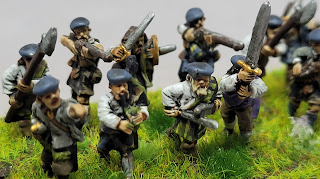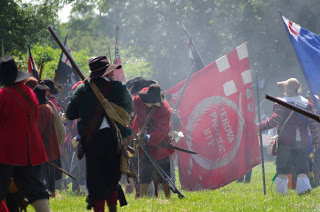The Auxiliary Regiments of the London Trained Bands: Blue Coats?
Regular readers (hello both of you) will know that I have a bit of a bee in my bonnet about Wargamer Facts ™. Here's the latest Wargamer Fact ™ to go under the KeepYourPowderDry investigative microscope.
By default this post has become part of my coat colours series. You can find the rest of the posts here:
Part 1 Parliamentarian coat colours
Part 2 Royalist coat colours
Part 3 Scots coat colours
Part 4 Dragoons, Horse and the New Model Army coat colours
The Trained Bands
Having seen the phrase "the London Auxiliaries may have received blue coats" many times I decided to look into the source of this information. Just as another wargamer fact™ asserts that the London Trained Band wore red coats*, this "blue coats" fact™ would seem to be on equally shaky ground.
The Trained Bands were a system of militia organisation formalised by Elizabeth I to negate the need for a large standing army. Organised locally, and administered by local dignitaries, men of good standing (in other words, what we now consider to be 'middle class'), were compelled to join the local trained band. In early Stuart times arms and armour were often provided, sometimes other items were provided - such as coats. The middle classes who were compelled to join were merchants and tradesmen whose primary thoughts were their own businesses, not being a soldier.
Roll on a few years to the outbreak of the Civil Wars; 11 miles of defences were thrown up around London, and it was the duty of the London Trained Bands to man these fortifications and protect the city. London had sided with Parliament and the LTB were also ordered to join the Southern Association and the Earl of Essex's armies.
All this was a bit much for the LTB soldiers who still had businesses to run: so Auxiliary Regiments were raised to allow the LTB men to return to their commercial interests. These Auxiliary Regiments were raised from apprentice boys, the poor - those who were not eligible to join the LTB. Each of the six city regiments, and the three suburban regiments raised an Auxiliary Regiment.
Auxiliaries were not just a 'London thing', auxiliary regiments were raised throughout England, mostly for garrison and defensive duties.
Let's fast forward to the second half of 1644...
Parliament is struggling to pay its soldiers, and plague is rife. The Red, White and Blue Auxiliaries have been garrisoned in Abingdon: all three regiments have been decimated by desertion and plague. The Governor of Abingdon, Major-General Richard Browne had been the senior captain in the Orange regiment of the London Trained bands. He wrote to the Committee of Both Kingdoms explaining the Auxiliaries' predicament
"We find provisions here very scarce, and hardly to be had for money, so that our wants are like to be great. Our quarters are also exceedingly strait, so that there are near ten men in a room, besides many sick" Browne's letter to the Committee of Both Kingdoms, mid August 1644, Calendar of State Papers, Domestic 1644 p427
Things just got worse, Browne wrote again in early October
"We have 500 fallen sick of late, and one or two being perished for want of clothes have died in the streets. I beg you to pity our sad condition...The officers...being left almost without men, humbly desire there may be present course taken for recruiting their companies and clothing the soldiers they have left, or else that these may be disbanded" The True Informer 5-12 October E12/17
He would write again
"I hear there is £2000 coming to us, but that will do little good, only supplying the soldiers shoes to run away" Calendar of State Papers, Domestic 1644-5 p84
The Committee of Both Kingdoms would send extra supplies shortly before Christmas
"We have taken care to send provisions to Abingdon for the relief and clothing of the forces in your garrison there. You are to take care that those only be clothed of whom you can have assurance they intend to tarry there during the winter and to do service and not to depart when they are refurnished." Calendar of State Papers, Domestic 1644-5 p193
The three regiments were so reduced in numbers that on the 26th December the Committee wrote to the Militia Committee
"The three regiments of City Auxiliaries at Abingdon are so weak that it would be well to have them reduced into one, many of the officers being willing to be reduced and so save unnecessary charge to the State. We leave you to the manner of doing it as being best acquainted with the state of those regiments" Calendar of State Papers, Domestic 1644-5 p195
The Red, White and Blue Auxiliaries now cease to exist, and have been reformed as Colonel George Paine's Regiment of Foot. George Paine (often written as Payne) had been a captain in the Red Regiment of the London Trained Bands.
Paine's were garrisoned in Abingdon in April 1645, where they were noted as blue coats. British Library Add. 18,982 f409
The Red, White and Blue Auxiliary Regiments would be raised anew in 1646.
So did the Auxiliaries wear blue coats?
They were desperately short of clothing (all clothing) which was supplied about the same time that the regiments were reduced and became Paine's Regiment of Foot. Unfortunately we don't know if they received coats: although if they are freezing to death in the streets we must presume that they did. We do not know of any standardised coat colour(s).
We know that Paine's were still in Abingdon four months later in April 1645; Paine's, and the other two volunteer regiments present in Abingdon had been ordered to be recruited to full strength. Paine's were noted as being clothed in blue coats. We don't know if they were issued these blue coats as Paine's (possible if they had had an influx of recruits), or if these blue coats were part of the clothing sent by the Committee of Two Kingdoms in December 1644.
If one decided to split hairs, the Auxiliaries didn't wear blue coats, as they had stopped being Auxiliaries at the time of the clothing issue. Pedants would counter this with there being no exact dates for clothing issue (believed to arrived in the town sometime around the 22nd December) and reduction (ordered 26th December, but not enacted upon that date) - but this difference would only be a few days or weeks difference at most. Certainly the Auxiliaries never took the field in these newly issued clothes.
* regular readers (hello, again, both of you) will know that this is one of my bugbears, and has resulted in walls of text postulating that it is utter nonsense. You can find some of it here.









.jfif)





Comments
Post a Comment